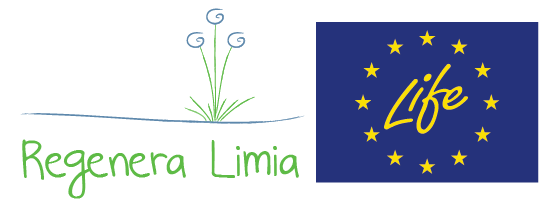Riverbeds
[cmsms_row data_padding_bottom=”50″ data_padding_top=”0″ data_overlay_opacity=”50″ data_color_overlay=”#000000″ data_bg_parallax_ratio=”0.5″ data_bg_size=”cover” data_bg_attachment=”scroll” data_bg_repeat=”no-repeat” data_bg_position=”top center” data_bg_color=”#ffffff” data_color=”default” data_padding_right=”3″ data_padding_left=”3″ data_width=”boxed”][cmsms_column data_width=”1/1″]
[cmsms_divider type=”transparent” margin_top=”20″ margin_bottom=”20″ animation_delay=”0″]
[cmsms_text animation_delay=”0″]
What have the jobs consisted of?
Performance 1
It has recovered and rehabilitated an old river meander of the river Limia in As Veigas of Ponteliñares of approximately one kilometer, for the improvement of the capacity of retention and assimilation of nutrients.
At the time of the desiccation of the former Laguna de Antela, the Limia river was channeled and rectified, giving rise to its current rectilinear layout, and causing that its old meanders did not return to circulate water, only the rainwater collected from the surrounding plots . This led to a limitation of its function as a river ecosystem of the river itself, isolating from these processes the old meander, which even became a depressed area where there were phenomena of water accumulation, thus creating wet areas without connection.
[/cmsms_text][cmsms_image align=”center” link=”http://regeneralimia.org/wp-content/uploads/2017/05/1.png” animation_delay=”0″]4817|http://regeneralimia.org/wp-content/uploads/2017/05/1.png|full[/cmsms_image]
[cmsms_divider type=”transparent” margin_top=”20″ margin_bottom=”20″ animation_delay=”0″]
[cmsms_text animation_delay=”0″]
Part of this meander was filled, in the old canalization works, with the leftover material of the creation of the new river channel Limia. It is in this section where a new channel has been created, removing the materials of filling, and endowing it with very sloped slopes so that it forms a plain of flood connected with the channel. They also have been planted in the new channel macrophyte species (sps) typical of the river ecosystem, previously collecting them from the current Limia river, which are specialized in the uptake and retention of nutrients through their radical systems.
[/cmsms_text]
[cmsms_divider type=”transparent” margin_top=”20″ margin_bottom=”20″ animation_delay=”0″]
[cmsms_gallery layout=”gallery” image_size_gallery=”medium” gallery_columns=”4″ gallery_links=”lightbox” animation_delay=”0″]4804|http://regeneralimia.org/wp-content/uploads/2017/05/2-200×200.jpg,4805|http://regeneralimia.org/wp-content/uploads/2017/05/3-200×200.png,4873|http://regeneralimia.org/wp-content/uploads/2017/05/apertura2-200×200.jpg,4874|http://regeneralimia.org/wp-content/uploads/2017/05/apertura3-200×200.png[/cmsms_gallery][cmsms_text animation_delay=”0″]
The main recovery actions of the old meander have basically consisted of:
- The execution of silvicultural works on the existing riparian vegetation, pruning, elimination of dead specimens mainly alders, birches and willows dominated with danger of falling on the channel, elimination of obstructions of the channel by dead vegetation.
- The rehabilitation of the old channel, by reopening it, with a longitudinal slope adequate to allow water circulation, excavating the river bed and extracting large amounts of sediments and deposited plant remains. During the excavation, in the areas where it was possible, slopes were laid out with the aim of naturalizing the river to the maximum, thus creating zones of rapid and slow water passage. Also, the new channel was connected with the small lagoons of natural and artificial origin that existed in the zone, to cause that the water stays as long as possible in the veigas and to enhance in this way the purifying function of the vegetation.
- The connection of the recovered meander with the current channel of the Limia river, disconnected by the service route that accompanies the current channel, through the construction of two works of passage, one of entrance and another of exit, realized with prefabricated frames and fins of stone of uneven rock. The interior of the frames was covered with stone bed in order to integrate them landscape and favor sedimentation. The embankments were reforested with a coconut blanket, herbaceous planting and willow staking, so that it will be the vegetation itself that is in charge of integrating environmentally the works carried out.
[/cmsms_text][cmsms_gallery layout=”gallery” image_size_gallery=”medium” gallery_columns=”4″ gallery_links=”lightbox” animation_delay=”0″]4875|http://regeneralimia.org/wp-content/uploads/2017/05/obras11-200×200.jpg,4876|http://regeneralimia.org/wp-content/uploads/2017/05/obras21-200×200.jpg,4877|http://regeneralimia.org/wp-content/uploads/2017/05/obras3-200×200.png,4878|http://regeneralimia.org/wp-content/uploads/2017/05/obras4-200×200.jpg[/cmsms_gallery][cmsms_text animation_delay=”0″]
The recovered meander first came into operation last February when the Limia River reached 0.50 m, it is expected to occur during the months of November to April.
[/cmsms_text][cmsms_gallery layout=”gallery” image_size_gallery=”medium” gallery_columns=”2″ gallery_links=”lightbox” animation_delay=”0″]4879|http://regeneralimia.org/wp-content/uploads/2017/05/entradaagua1-200×200.jpg,4880|http://regeneralimia.org/wp-content/uploads/2017/05/entradaagua2-200×200.jpg[/cmsms_gallery][cmsms_text animation_delay=”0″]
After the recovery of the meander, work began to follow the improvement of water quality after its passage through the new channel, and the regenerated ecosystem. To this end, both partners, CHMS and DXCN, have developed a system to monitor the different parameters of water quality and biological indicators that will allow to know the performance of the action, that is, the self-depleting capacity of the ecosystem recovered and regeneration of new ecosystems.
[/cmsms_text]
[cmsms_divider type=”transparent” margin_top=”20″ margin_bottom=”20″ animation_delay=”0″]
[cmsms_gallery layout=”gallery” image_size_gallery=”medium” gallery_columns=”2″ gallery_links=”lightbox” animation_delay=”0″]4881|http://regeneralimia.org/wp-content/uploads/2017/05/entradaagua3-200×200.jpg,4882|http://regeneralimia.org/wp-content/uploads/2017/05/entradaagua4-200×200.jpg[/cmsms_gallery][/cmsms_column][/cmsms_row]
